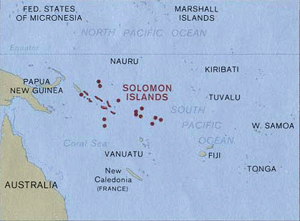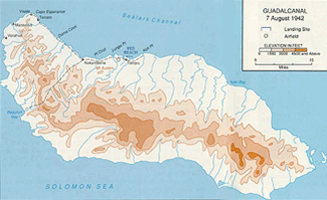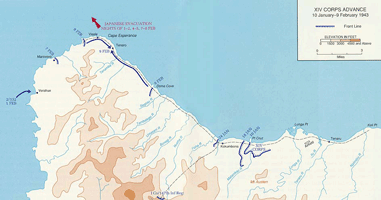| Join | Official Historian | City of Stamford | Blog | About Us | |
| Jewish Historical Society | Civil War Roundtable | Contact Us | |
|
|
|
|
The Stamford Historical Society PresentsPride and Patriotism: Stamford’s Role in World War II
|
 full size map of the island chain |
The Battle of Guadalcanal was fought on the island of Guadalcanal in the southern Russell Islands of the Solomon Island Archipelago from 7 August 1942 until 9 February 1943. Although small in comparison to later battles in the Pacific, Guadalcanal was one of the most significant, in that it was the first offensive by US land forces in the Pacific Campaign. The Allied navy and 16,000 troops were launched against Guadalcanal itself, with additional landings made on the islands of Florida, Tulagi, Gavutu and Tanambogo.
Guadalcanal is in the middle of the long Solomon Chain. The Solomons were key to Japanese strategy, as forces there could help cut off shipping between the United States and Australia. The Japanese had established a major base at Rabaul in the northern Solomons, but aircraft from Rabaul could not patrol the whole island chain effectively. As of 1942 the Japanese Navy had begun occupying all islands in the chain to create a bulwark against any potential Allied advance and to build airfields and airbases for land based patrol bombers. Guadalcanal’s location in the middle of the chain and proximity to Rabaul made it an ideal location for a key defensive role. For these reasons it was crucial for the Allies to seize the island before the Japanese could build their bases.
Allied forces were composed of units from Australia, New Zealand, Fiji, Tonga, the Solomons and the United States. Admiral Frank Fletcher served as the tactical commander, while General Vandegrift served as leader of the ground forces. The total Allied strength was some 29,000 men as of November 12. They faced some 30,000 Japanese troops under the command of Hyakutake Haruyoshi (ground force commander) and Admiral Gunichi Mikawa.
On 7 August the 1st Marine Division executed an amphibious landing east of the Tenaru River. Initially, only unarmed Japanese construction and support personnel occupied Guadalcanal, so the American assault was unopposed. A nearby airstrip was quickly captured and named Henderson Field after Major Lofton Henderson, who had been killed at the Battle of Midway. On 8 August Admiral Fletcher pulled his carriers away from Guadalcanal, taking with him over half the Marines’ supplies and all their heavy artillery.

Guadalcanal 7 August 1942, larger image
Upon learning of the landing, the Japanese at Rabaul quickly sent reinforcements to destroy the Americans and take back the airfield (Operation Ka-Go). The Japanese troops were under the 17th Army commanded by Lt. General Hyakutake Haruyoshi.
The first major battle was fought on the Tenaru River on 20 August, when the Japanese Ichiki Detachment attacked the Marines. All the Japanese troops were slaughtered and their commander committed seppaku. In mid-September, a night assault was launched by 6000 Japanese against 11,000 Marines to take back the airfield. The battle of Edson’s Ridge – called the Battle of Bloody Ridge by some – lasted from 11 September to 14 September before the attack was finally repulsed.
There followed a period of little movement until 13/14 October, when the Japanese again shelled the airfield. This was followed on 23 October by another assault by Japanese troops to take the field. The newly arrived US Army 164th Infantry Regiment and 1st Battalion of the 7th Marines defend the positions and finally repulsed the assault. By the end of the evening of 25 October the Japanese 29th Infantry Regiment had lost 553 killed or missing and 479 wounded among its 2554 men. Total Japanese losses during that battle were as high as 2200.
Japanese attempts to reinforce their troops in November were thwarted by the Naval battle of Guadalcanal, during which transports were damaged or lost. The Japanese continued to lose ground during December and January due to attrition and shortages of supplies. The US XIV Corps began an offensive on 10 January 1943 that culminated in the evacuation by the Japanese of their remaining forces from Cape Esperance on 8 February. The U.S. declared the island secure on 9 February 1943.

Guadalcanal 10 January to 9 February 1943 larger image
The battle set a pattern for costly conflicts, especially on the Japanese side. While the Allies suffered some 1492 killed and 1000 wounded; the Japanese lost 15,000 killed in action and another 9000 died from malaria.
| Myles Fox Cortland Mehl William Rudman |
Guadalcanal Campaign with many links! From the U.S. Army Center of Military History: Guadalcanal. Extensive site! The Pacific and Adjacent Theatres 1942 (map) |
Introduction
Veterans
Battles
Stamford Service Rolls
Homefront
Exhibit Photos
Opening Day